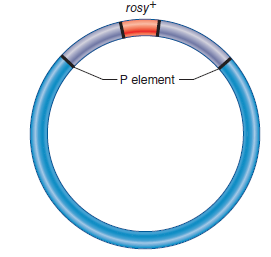
Genetics: Analysis and Principles 5th Edition by Robert Brooker
Edition 5ISBN: 978-0073525341
Genetics: Analysis and Principles 5th Edition by Robert Brooker
Edition 5ISBN: 978-0073525341 Exercise 16
Gerald Rubin and Allan Spradling devised a method of introducing a transposon into Drosophila. This approach has been important for the transposon tagging of many Drosophila genes. They began with a P element that had been cloned on a plasmid. (Note: Methods of cloning are described in Chapter 20.) Using cloning methods, they inserted the wild-type allele for the rosy gene into the P element in this plasmid. The recessive allele, rosy , results in a rosy eye color, while the wild-type allele, rosy + , produces red eyes. This plasmid also has an intact transposase gene. The cloned DNA is shown here. 
a.
They used a micropipette to inject this DNA into regions of embryos that would later become reproductive cells. These embryos were originally homozygous for the recessive rosy allele. However, the P element carrying the rosy + allele could "hop" out of the plasmid and into a chromosome of the cells that were destined to become germ cells (i.e., sperm or egg cells). After they had matured to adults, these flies were then mated to flies that were homozygous for the recessive rosy allele. If offspring inherited a chromosome carrying the P element with the rosy + gene, such offspring would have red eyes. Therefore, the phenotype of red eyes provided a way to identify offspring that had a P element insertion.Now here is the question. Let's suppose you were interested in identifying genes that play a role in wing development. Outline the experimental steps you would follow, using the plasmid with the P element containing the rosy + gene, as a way to transposon tag genes that play a role in wing development. Note: You should assume that the inactivation of a gene involved in wing development would cause an abnormality in wing shape. Also keep in mind that most P element insertions inactivate genes and may be inherited in a recessive manner.

a.
They used a micropipette to inject this DNA into regions of embryos that would later become reproductive cells. These embryos were originally homozygous for the recessive rosy allele. However, the P element carrying the rosy + allele could "hop" out of the plasmid and into a chromosome of the cells that were destined to become germ cells (i.e., sperm or egg cells). After they had matured to adults, these flies were then mated to flies that were homozygous for the recessive rosy allele. If offspring inherited a chromosome carrying the P element with the rosy + gene, such offspring would have red eyes. Therefore, the phenotype of red eyes provided a way to identify offspring that had a P element insertion.Now here is the question. Let's suppose you were interested in identifying genes that play a role in wing development. Outline the experimental steps you would follow, using the plasmid with the P element containing the rosy + gene, as a way to transposon tag genes that play a role in wing development. Note: You should assume that the inactivation of a gene involved in wing development would cause an abnormality in wing shape. Also keep in mind that most P element insertions inactivate genes and may be inherited in a recessive manner.
Explanation
In this question, we discuss using a rec...
Genetics: Analysis and Principles 5th Edition by Robert Brooker
Why don’t you like this exercise?
Other Minimum 8 character and maximum 255 character
Character 255



